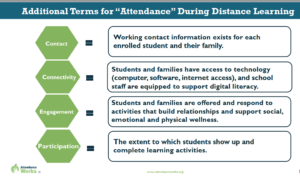“All MUSD students must submit a weekly log to the school “for evidence of learning time.” Each student must also either be present for the daily synchronous lessons or submit work for the day on an online platform. “
Category: Resources & Forms
Aug 31
Measuring Daily Attendance and Participation During COVID-19 – An Invaluable Tool for Reducing Educational Inequity
“Until new research examining absenteeism in blended or distance learning settings can be conducted, we advise continuing to monitor which and how many students miss 10% or more of learning opportunities.”
Aug 29
A guide to planning transitions to school – Transition Attendance Analysis Tool
“If you have a plan, the results can serve as a checklist to make sure you’ve addressed inequities, haven’t missed a critical ingredient and anticipated what might happen during the next school year. “
Jan 08
Physical health and attendance are co-related. So, how sick is too sick to go to school?
From Attendance Works “Illness plays a significant role in early childhood absences. Help families understand when to send a child to school or keep her home and manage chronic conditions. When illness-related absences begin to add up, you can bring it to the attention of others, such as the school’s family outreach or health staff …
Dec 22
Student mobility and transfers from school to school has an impact on chronic absenteeism
“While some foster students choose to miss school for a variety of social or emotional reasons, foster care advocates pinpoint their constant mobility as the significant cause behind absences. “With each move, six months of instructional time is lost,” said Margaret Olmos, director of FosterEd California, a project of the National Center for Youth Law, …









